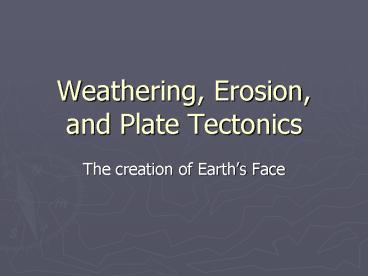Weathering, Erosion, and Plate Tectonics - PowerPoint PPT Presentation
1 / 15
Title:
Weathering, Erosion, and Plate Tectonics
Description:
The creation of Earth s Face Questions What forces and phenomena create the different features of the earth? What are tectonic plates? What are the three major ... – PowerPoint PPT presentation
Number of Views:114
Avg rating:3.0/5.0
Title: Weathering, Erosion, and Plate Tectonics
1
Weathering, Erosion, and Plate Tectonics
- The creation of Earths Face
2
Questions
- What forces and phenomena create the different
features of the earth? - What are tectonic plates?
- What are the three major Types of Plate
Boundaries? - What are the two external processes that change
the earths surface? - What are the different types of Weathering and
Erosion?
3
Forces that change the Earths Surface
- There are two major geological processes that
create features on the earth - Faulting and Plate Tectonics
- Weathering and Erosion
- They both take a long time to change the earth.
- Remember, nothing drastic on earth happens at
human speeds.
4
Plate Tectonics
- Huge volumes of heated and molten rock moving
around the earths interior form massive solid
plates that move extremely slowly across the
earths surface. - Tectonic plates huge rigid plates that are moved
with convection cells or currents by floating on
magma or molten rock.
5
The Earths Major Tectonic Plates
Figure 15-4
6
The Earths Major Tectonic Plates
- The extremely slow movements of these plates
cause them to grind into one another at
convergent plate boundaries, move apart at
divergent plate boundaries and slide past at
transform plate boundaries.
Figure 15-4
7
Fig. 15-4, p. 338
8
EURASIAN PLATE
NORTH AMERICAN PLATE
ANATOLIAN PLATE
CARIBBEAN PLATE
JUAN DE FUCA PLATE
CHINA SUBPLATE
ARABIAN PLATE
PHILIPPINE PLATE
AFRICAN PLATE
PACIFIC PLATE
SOUTH AMERICAN PLATE
NAZCA PLATE
INDIA-AUSTRALIAN PLATE
SOMALIAN SUBPLATE
ANTARCTIC PLATE
Divergent plate boundaries
Convergent plate boundaries
Transform faults
Fig. 15-4a, p. 338
9
Trench
Volcanic island arc
Craton
Transform fault
Lithosphere
Rising magma
Lithosphere
Subduction zone
Lithosphere
Asthenosphere
Asthenosphere
Asthenosphere
Divergent plate boundaries
Convergent plate boundaries
Transform faults
Fig. 15-4b, p. 338
10
GEOLOGIC PROCESSES
- The San Andreas Fault is an example of a
transform fault.
Figure 15-5
11
Wearing Down and Building Up the Earths Surface
- Weathering is an external process that wears the
earths surface down.
Figure 15-6
12
Weathering
- Three types of weathering
- Physical
- Big Rock becomes Small Rock due to wind, rain,
and frost wedging. - Frost wedging occurs when water freezes in
between the pores of large sedimentary rocks. - Chemical
- When a chemical reaction degrades or decompose
rock. - More common with rocks containing carbon and
oxygen, like limestone. - Biological
- Conversion of Rock and Minerals into smaller
particles due to living thing. - Lichens, Tree Roots, Earthworms.
13
Parent material (rock)
Biological weathering (tree roots and lichens)
Chemical weathering (water, acids, and gases)
Physical weathering (wind, rain, thermal
expansion and contraction, water freezing)
Particles of parent material
Fig. 15-6, p. 340
14
Erosion
- Erosion is another major external factor that
changes the surface of the earth. - Erosion is different from weathering because
erosion deposits materials from one place to
another. - Two major examples of erosion
- Glacial Movement and Melt
- Mass Wasting
15
Glacial Movement and Mass Wasting
- Glacial Movement
- The Movement of Glaciers grind away mountainsides
and form basins to capture melted ice water - The Great Lakes were formed using this method.
- Mass Wasting
- When Rock and soil masses become detached from
underlying material and move downhill under the
influence of gravity. - Rockslides, Mudslides, and Landslides
- Clearing of Trees and other vegetation increase
Mass Wasting Occurrences.































